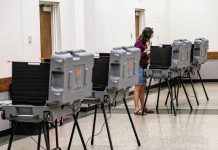Six teachers’ unions in southern and central Indiana are calling on legislators to restore collective bargaining rights.
The Columbus Educators Association, the Flat Rock-Hawcreek Teachers Association, the Edinburgh Educators Association, the Jennings County Classroom Teachers Association, the Seymour Education Association, and the North Lawrence Education Association sent out a joint press release containing an open letter to state legislators Feb. 18.
The teachers’ associations directed their letter to state senators Greg Walker, Eric Koch and Chip Perfect, as well as state representatives Ryan Lauer, Jim Lucas, Sean Eberhart, Randy Frye and Chris May.
“We are writing to collectively urge you to take action this year to restore educator bargaining rights for workload, working conditions, and hours, while also allowing other topics to be bargained if both the union and administration agree to it,” the letter stated.
Union leaders said in the letter that restoring bargaining rights would help improve the quality of education, as well as educator retention and pay.
CEA second vice president Dakota Hudelson facilitated the collaboration, reaching out to most of the other unions and incorporating different edits into the final letter. The CEA has not heard back from area legislators about the letter. He added that, to his knowledge, the other union leaders have not heard from their legislators either regarding collective bargaining.
At present, Indiana Code 20-29-6-4 states that teachers’ unions can participate in collective bargaining in regards to salary, wages and benefits.
Matters that cannot be collectively bargained include, but are not limited to, school calendars, teacher dismissal procedures and criteria, and “any subject not expressly listed in section 4.”
Hudelson said that most teachers’ unions across Indiana agree on “the necessity of restoring bargaining rights.” All six local unions care about the issue, he said, and joined together in their efforts to call attention to it.
The main reason for concern is teacher retention, Hudelson said. According to an internal CEA survey, more than 25% of teachers in the Bartholomew Consolidated School Corp. are “seriously considering leaving BCSC after this year.”
Hudelson said that while the survey was made up of almost 400 CEA members and did not include non-union teachers, the CEA believes it to be a “representative sample.”
“I don’t know if that’s to go to another school corporation,” he said. “I don’t know if that’s to leaving teaching entirely. I don’t know. It doesn’t matter. (The) 25% is a horrifying number, and it’s one that really alarmed us.”
Hudelson noted that the figure is especially concerning given that it comes in the wake of BCSC’s successful referendum which, among other items, includes salary increases for teachers based on their years of experience in and outside of the school corporation. The salary agreement approved by the school corporation and CEA in October also stated that teachers who didn’t qualify for those increases would receive a stipend in January.
Hudelson said this indicates that “money is not the problem”; instead, other issues are driving teachers to consider leaving. He said that if the CEA had the ability to address these issues through collective bargaining, it would be more likely to keep teachers in the school corporation and the community.
Hudelson noted that working conditions are one of teachers’ primary concerns.
The letter to legislators likewise stated that “If educators know that they will have a seat at the table in the future when it comes to their workload, working conditions, hours, and more, they will be much more likely to stay in our counties working hard for our students.”
When asked if COVID-19 was among their concerns in regards to working conditions, Hudelson indicated that this was the case.
“To a degree, yes,” he said. “I mean, it’s no secret that our members, when this school year started, were not confident in BCSC’s reopening plan. And, to be honest with you, teachers across the board, I think, are still bringing up a lot of concerns with our operating plan, as it is now.”
Hudelson said he believes that if teachers had been able to bargain working conditions at the beginning of the school year, the year would have gotten off to a “safer” start, and there would have been more satisfaction on all sides. As it was, the CEA felt like there wasn’t a lot of teacher input in the process, Hudelson said.
In addition to working conditions, the unions stated that they also wish to take education initiatives to the bargaining table.
“Educators that work with students on a regular basis each day have a very unique perspective on what those students need in order to be successful,” the letter stated. “…Educators AND students are more likely to fully engage in learning initiatives if educators were at the table helping develop them from the beginning.”
This would increase both teacher and school district “buy-in” with initiatives, Hudelson said. At present, the school corporation has a “top-down model” where administrators and higher-ups come up with ideas for these initiatives, according to Hudelson. Many of these ideas are “wonderful,” he said, but others might be more confusing.
Administrators pass these initiatives on to teachers, who have to put them into practice in the classroom, and the process has “mixed results,” Hudelson concluded.
If teachers were able to bargain on educational initiatives, there would be more of a “horizontal decision-making process” and more in-depth discussions about expectations for teachers, Hudelson said.
“If we are able to bargain topics like that with them, then we believe that that will increase teacher buy-in on a lot of these different programs,” he said. “The admin will be explaining things a little bit more clearly, and that’s only going to improve the educational quality for students.”
Concern over initiatives also ties into working conditions. “Sometimes things that look really good on paper and that sound really nice in a meeting with administrators can be really tricky to implement, whenever it comes time to do it in the classroom,” Hudelson said.
If teachers heard about initiatives early on at the bargaining table, they could provide input to “ease the transition” of implementing these initiatives at a classroom level.
The teachers’ associations also said that having more bargaining rights would give them more leverage overall as they bargain for pay.
“We know that when funding stays in the classroom and attracts the best educators, our students, schools, and communities benefit,” the letter stated.
Hudelson said that, for instance, if administrators wanted to enact a new initiative that would be “labor-intensive,” the CEA could use that as a bargaining chip “to leverage more dollars into the classroom.” More bargaining rights would help make sure that money goes where it’s needed and funds education initiatives the community supports, according to Hudelson.
As part of their push for increased bargaining rights, the six teachers’ unions organized a “blackout” on Wednesday. On social media, the CEA encouraged individuals to wear black and contact policymakers about the need for greater bargaining rights, “fully and equitably funded” public education and increased teacher pay. The event called not just for teachers to participate, but also “supporters of public education.”
Hudelson said that while the blackout was originally the local unions’ idea, it turned into a statewide event, with teachers’ unions across Indiana participating and the Indiana State Teachers’ Association promoting the demonstration.
The blackout also sparked the hashtag #Blackout4Ed, with individuals tweeting pictures of their attire and stating the educational issues they support, including opposition to voucher expansion and moving up teacher vaccinations.
Hudelson said that while he doesn’t agree with many legislators’ claims that teacher pay is a “local issue” and the state doesn’t need to contribute funds, restoring bargaining rights is a step that wouldn’t cost the state any money.
“If they really and truly did believe that the problem was local, and that they’re funding schools sufficiently, and the money’s just not getting the teacher paid the way that it’s supposed to, then they can give us more leverage at the bargaining table,” he said. “If we have that leverage, then we’ll make sure more dollars make it to the classroom, where it needs to be.”





